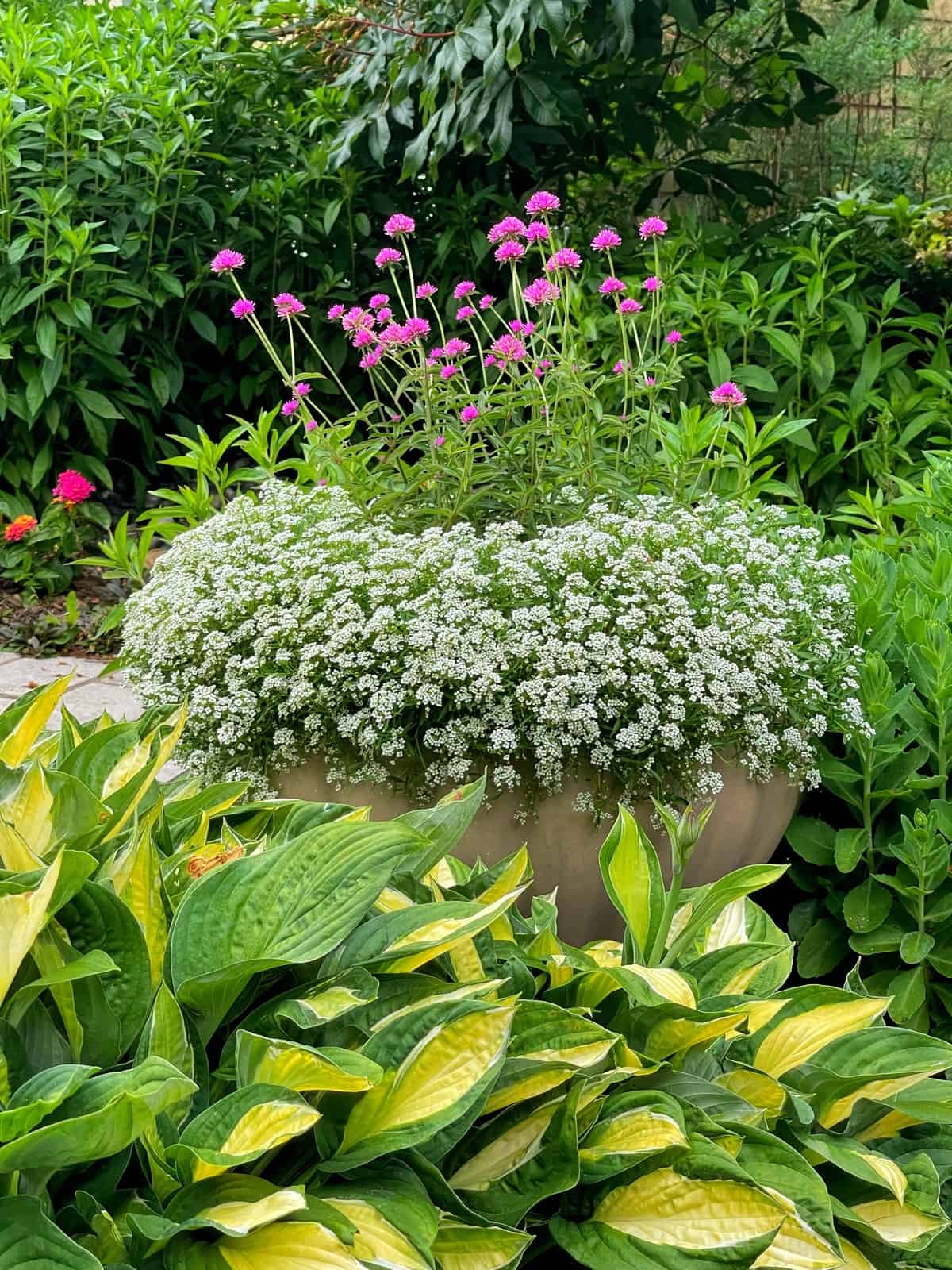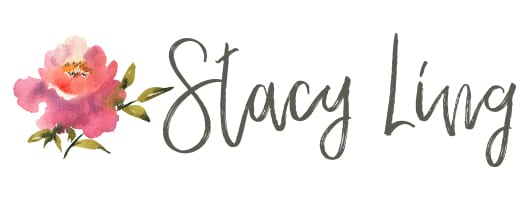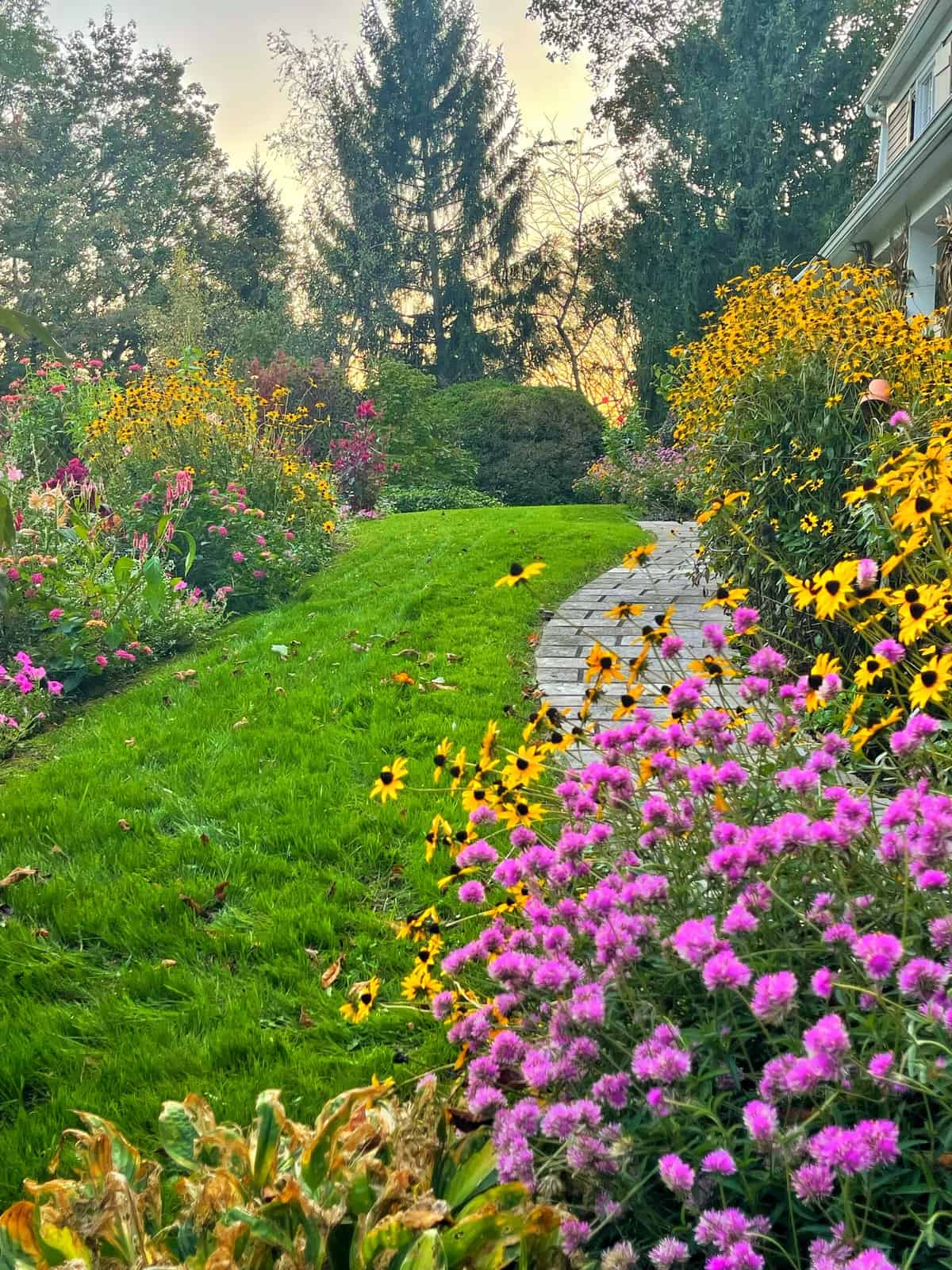Craving vibrant, low-maintenance blooms that last? Look no further than Gomphrena! Learn how to grow and care for globe amaranth with these simple tips.
Gomphrena is a charming flower that is like a gardener’s dream come true because it boasts stunning, long-lasting blooms that come in a range of eye-catching hues that looks amazing both in and out of the flower garden.
And the best part? It’s easy to grow and fuss-free too! Learn how to plant, grow, and enjoy gomphrena with these simple tips.
(Posts on stacyling.com may contain affiliate links. Click HERE for full disclosure.)

About Gomphrena
Gomphrena, also known as globe amaranth (Gomphrena globosa), is a genus of flowering plants in the Amaranthaceae family. These charming flowers are known for their vibrant, long-lasting blooms that resemble clover blossoms. They come in a variety of colors like red, pink, white, and purple – perfect for adding a pop of color to any garden!
Gomphrena is a fairly low-maintenance plant that thrives in USDA Hardiness Zones 2-11. While you can find some varieties at your local nursery, you’ll discover a wider selection if you start them from seed. Depending on the variety, Gomphrena ranges in size, but generally reaches about 1-2 feet tall and 6 inches to 1 foot wide. Some varieties can grow much wider, so be sure to read the plant label or seed packet directions for proper spacing.

Why I Love to Grow Gomphrena
There are countless reasons to fall in love with Gomphrena. First and foremost, it’s a long-blooming flower that adds lots of color and texture to flower gardens. From summer sunshine to the crisp days of fall, Gomphrena offers a continuous display of color that keeps your garden looking vibrant all season.
But here’s the best part: it’s a low-maintenance bloom to boot! Once established, Gomphrena requires minimal watering and feeding, making it perfect for busy gardeners or those new to gardening. It’s also pretty drought tolerant so it thrives in hot and dry climates.
But magic of globe amaranth doesn’t stop there. This little bloom also attracts a flurry of butterflies and other pollinators to your garden. Plus, its blooms dry beautifully, making Gomphrena a cut flower for long-lasting arrangements indoors.
And the best part? Gomphrena comes in a range of colors from classic red to vibrant pink, orange, white, and purple flowers, allowing you to create a color palette that perfectly complements your garden design.
Fun Fact: Gomphrena’s real showstoppers are the colorful bracts, not the hidden flowers. These bracts form stunning, papery globes that resemble clovers, guaranteed to grab attention.

How to Start Gomphrena Seeds Indoors
While you can find some starter plants at the nursery, there are so many other beautiful varieties that you can easily start from seed. It’s pretty easy to start globe amaranth seeds indoors too. Here’s what you need to know!
Must-Have Seed Starting Supplies
- Gomphrena Seeds (I usually buy mine from Johnnys Selected Seeds online)
- Vermiculite
- Seed Starting Potting Soil
- Seed Trays
- Bottom or Drainage Trays
- Clear Dome Lids
- Grow Lights
- Shelf System for Seedlings
- Heat Mat
- Plant Labels
- Oscillating Fan
- Programmable Timer

Directions for Starting Gomphrena Seeds
- Gomphrena Globosa can be started indoors about 6-8 weeks before the last frost date in your locality. Use a seed starting tray or small pots with drainage holes filled with a quality organic seed starter mix that is pre-moistened. I start mine under grow lights and have found great success starting them in both my basement and sunroom.
- Presoak Gomphrena seeds for 12-24 hours to aid with germination.
- Make a small hole then sow the seeds then lightly cover them with vermiculite. Sow only one variety per cell tray as the different plants will germinate at different times.
- Cover seed trays with a clear dome and move them under the grow lights on a heat mat to speed up germination. They typically germinate within a few days to a week.
- Remove the cover when the seeds start to germinate. It’s OK if they didn’t all germinate, more will grow after the cover is removed.
- Keep soil moist by bottom watering only.
- Before transplanting gomphrena seedlings outdoors, harden them off by gradually exposing them to outdoor conditions over fourteen days. When seedlings are hardened off and ready to plant in the garden, space gomphrena transplants in your flower garden about 8 inches apart after the last frost date. Spacing is really important so there’s enough airflow between plants to prevent problems like fungal diseases. Water young plants regularly, keeping the soil moist but not waterlogged.

Planting and Growing Gomphrena
Planting Gomphrena is a breeze. It thrives in full-sun locations with average soil that receives at least 6-8 hours of daily sunshine. However, some varieties can handle part shade as well.
When it comes to soil, Gomphrena isn’t picky. It prefers well-draining soil, but can even tolerate sandy or clay soils as long as it has good drainage. Space your plants according to the specific variety you choose.
Gomphrena combines well with several flowering annuals and looks beautiful in informal plantings or cottage gardens. Plant globe amaranth towards the front of your flower garden border for a vibrant and beautiful display.
To get a head start on the blooming season, you can start seeds indoors 6-8 weeks before the last frost. Once the danger of frost has passed and you’ve hardened them off, seeds can be transplanted to your seedlings outdoors. Pre-soaking your seeds overnight can improve germination rates. For most varieties, direct sowing is not recommended.
Caring for Your Gomphrena Flowers
Regular watering is important, especially during hot and dry spells. However, allow the soil to dry slightly between waterings to avoid overwatering.
When it comes to feeding, globe amaranth is a self-sufficient soul. Amending the soil with compost, leaf mold, and other organic matter is always a good idea before planting. If the soil is good, it rarely needs fertilizer. However, if grown in containers, it’s a good idea to feed it with a slow-release fertilizer.
For bushier growth and even more blooms, pinch back young plants to encourage branching and flower production. Deadheading flowers is optional but can help promote continued flowering.

Why Gomphrena Makes a Great Cut Flower
If you’re looking to create everlasting arrangements, Gomphrena is your friend. Globe amaranth makes a fantastic cut flower for several reasons:
- Long-lasting: Gomphrena’s biggest perk is its incredible vase life. The dried blooms can last for months, even years, with proper care! This makes them ideal for creating everlasting arrangements that add a pop of color to your home long after they’ve been cut .
- Vibrant Colors: Gomphrena boasts a range of eye-catching colors which allows you to create arrangements that complement any décor or occasion.
- Dries Beautifully: Unlike some flowers that turn dull or wilt when dried, Gomphrena retains its vibrant colors and papery texture exceptionally well. This ensures your arrangements stay beautiful for a long time.
- Low Maintenance: Even after being cut, Gomphrena requires minimal care. Simply place the stems in a vase without water and enjoy the long-lasting display.
- Adds Textural Interest: Gomphrena’s unique, papery blooms add a touch of texture to both your cut flower garden and bouquets, creating visual interest and dimension alongside other flowers.
Troubleshooting and Common Issues With Globe Amaranth
In general, gomphrena is fairly pest and disease-resistant. However, globe amaranth can be susceptible to powdery mildew, gray mold, and fungal leaf spots during extended periods of cool, damp weather.
Fungal diseases thrive in humid environments with poor air circulation so practice good watering techniques by watering the base of plants in the morning and ensure your plants have adequate spacing to promote airflow.
Deer are not particularly fond of gomphrena, so it is a great deer resistant flower for your garden.

How to Harvest and Dry Gomphrena Flower
One of the wonderful things about Gomphrena is how well it dries, allowing you to enjoy its vibrant colors long after the growing season ends. Here’s how to dry your Gomphrena flowers for everlasting arrangements:
1. Harvesting Globe Amaranth
- Timing is Key: Harvest Gomphrena flowers when they are fully open but before they begin to fade. This ensures the most vibrant color in your dried blooms.
- Cut Stems: Use sharp, clean scissors or pruners to cut the stems to your desired length. Leave a few inches of stem for arranging.
2. Preparing for Drying
- Remove Foliage: Strip the leaves from the stems. Leaves tend to become brittle and crumble when dried, making your arrangements look messy.
- Bundle (Optional): If you plan to dry a large quantity, you can bundle the stems together with a rubber band. Avoid using twine or string, as the stems will shrink as they dry.

3. Drying Methods
- Air Drying:
- Hang Upside Down: This is the most common and effective method. Tie the stems together (or use a rubber band for bundles) and hang them upside down in a cool, dark, dry, and well-ventilated area. A closet, attic, or shed works well.
- Avoid Direct Sunlight: Sunlight can fade the colors of your drying flowers.
- Drying Time: Gomphrena typically takes 2-4 weeks to dry completely. The flowers will feel papery and stiff to the touch when they’re ready.
- Silica Gel:
- Faster Drying: This method is faster than air drying, taking only a few days.
- How to: Bury the flower heads completely in a container filled with silica gel beads. Seal the container airtight.
4. Storing Dried Gomphrena
- Keep Away from Moisture: Store your dried Gomphrena in a cool, dry place away from direct sunlight and humidity.
- Handle with Care: Dried flowers are delicate, so handle them gently to avoid breakage.

Tips for Success
- Harvest in the Morning: The flowers contain less moisture in the morning, which can speed up the drying process.
- Experiment with Drying Times: The drying time can vary depending on the humidity and temperature of your drying environment. Check your flowers periodically to gauge their dryness.
- Enjoy the Process: Drying flowers is a rewarding way to preserve the beauty of your garden and create lasting memories.

Flowers That Look Amazing With Gomphrena
After growing globe amaranth, there are certain flowers I thought looked incredible within the gardens. Here’s my short list of plants that complement gomphrena.
- Rudbeckia
- Sedum Autumn Joy
- Petunias
- Calibrachoa
- Coneflowers
- Blazing Star
- Lantana
- Monarda
- Achillea
- Coreopsis
- Pansies
- Zinnias
- Strawflowers
- Celosia
- Snapdragons
Favorite Gomphrena Varieties
I am super excited about this growing season because I am growing several varieties of gomphrena in my flower gardens. Here’s what I’m growing!
- Truffala Pink by Proven Winners
- QIS Pink
- Raspberry Cream
- QIS Carmine

Gomphrena FAQs
Do gomphrena come back every year?
Gomphrena is a warm season annual that is not frost tolerant in most locations. However, if you garden in zones 9-11 it can behave more like a perennial. Here in my zone 6b garden, I grow it as a summer flowering annual, planting in both garden beds and planters.
How many days does it take for gomphrena to bloom?
On average, it takes about 85-100 days for gomphrena to bloom after planting. This is why it’s better to start seeds early indoors so you get a longer bloom season. They love long, hot days and if you can get them going early enough, they’ll reward you with blooms sooner than later.
Can gomphrena grow in pots?
Yes, gomphrena can be grown in both flower garden beds and outdoor planters. I grew gomphrena ‘Truffala Pink’ by Proven Winners last year in both and they did equally well.
Does gomphrena reseed itself?
Since I’ve only grown it for a season, I have not had the experience of globe amaranth reseeding itself. However, I’ve read that it can sometimes reseed with ease. I’ll update this post when I see my gardens this spring.

More About Growing Globe Amaranth
Gomphrena is a low-maintenance bloomer that delivers vibrant color, attracts pollinators, and provides stunning cut flowers. Its easy-going nature makes it perfect for beginner gardeners and seasoned green thumbs alike. So, why not add a touch of Gomphrena magic to your garden and enjoy its effortless beauty all season long?
Have you ever grown gomphrena before? If so, what varieties? Do you have any tips for growing or caring for them? I would love to know more in the comments below.
For more information about growing gomphrena please see the University of Wisconsin Cooperative Extension.
To drill down on more beginner gardening techniques and tips, please read these posts:
- Flower Gardening 101
- Growing a Cut Flower Garden for Beginners
- Container Garden Ideas for Beginners
- How to Start a Vegetable Garden
- Herb Gardening for Beginners
Thank you so much for following along.
Enjoy a beautiful day! xo









